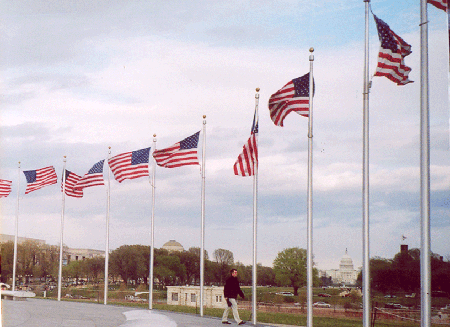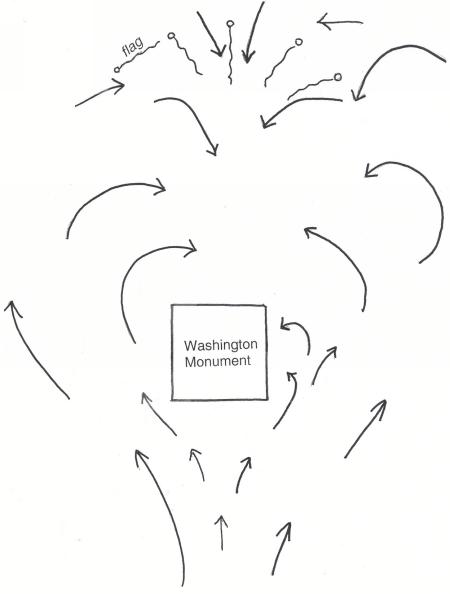Watching the wind
Thursday, August 17th, 2006GLOBE has protocols for measuring temperature, relative humidity, air pressure, and even aerosols. Did you ever wonder why there isn’t a protocol to measure wind? This picture can give you a hint. The flags in the picture are some of the flags that form a circle around the Washington Monument, in Washington D.C.

Flags on the lee side of the Washington Monument, in Washington, D.C. The flags are wonderful indicators of the varying wind.
We are watching the flags downwind of the Monument. You notice how the flags are all different? This is because the wind, blocked by the Monument, forms eddies on the downwind side. So, even though the wind is over 45 kilometers per hour out of the northwest, the flag in the middle shows that the wind is blowing almost as strongly from the opposite direction! And the flag just to the right of the middle one shows that the wind affecting it is rather slow. Finally, the flags on the left and right side of the picture are being blown southeastward — that is, they show a northwest wind. I include a sketch — with some flags — on how the flags show which way the wind is blowing.

Arrows showing how the wind blows around the Washington Monument. The little circles (poles) with squiggly lines (flags) show how the wind blows the flags. Only a few flags are shown. Imagine how the flags would be blowing in other places.
If we had a film of the flags, we would see them changing rapidly because the wind is changing rapidly. So the little arrows on the sketch are just at an instant in time. But, on average, the wind downwind (or on the lee side) of the Washington Monument would be slower than the wind on its upwind side. In a similar way, the house or apartment you live in or your school building blocks the wind. If the wind is out of the south, and you are on the south side of any of these buildings, the wind would be stronger than if you are on the north side. And, you would see lighter winds for a longer distance than you might think! Once, with a group of 4th-6th-grade students, I walked around their school building with a portable anemometer to measure the wind speed. Not only did the wind speed change a lot, but we could see that the trees and building were blocking the wind.
If you are interested in guessing the wind speed, a good way is to observe smoke, trees, blowing paper, or anything else the wind changes. For example, smoke going straight up means calm winds; and you can feel the wind on your face at 4-7 miles per hour (6-11 kilometers per hour). If you want to learn more about how to estimate wind speeds, find out about the Beaufort Scale for Land, at the web site: www.zetnet.co.uk/sigs/weather/Met_Codes/beaufort.htm. I used this scale when I took weather observations as a child.
So — keep your eyes open for flags, streamers, and wind socks — and watch the trees — to observe the wind in your area!